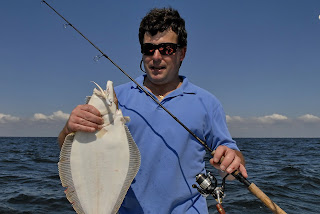 |
| Some days you eat the tuna and other days you don’t. |
The recriminations started on the drive home after the long trip offshore to catch tuna and maybe a white marlin with nothing to show for our efforts. Questions filled my head. Did we have the most recent information about fish activity? Did we have the right tackle, lures and baits? When we arrived at the area we chose should we have left sooner or stayed longer? Were other boats doing better in other areas? The list grew progressively longer as I replayed the entire trip, from preparation to on-the-water decisions, in my head.
Every angler regardless of what he fishes for has run up against that brick wall when no matter what you did you got skunked. You thought you did everything right and fished your heart out and ended up with nothing to show for it. This time the trip was from New Jersey’s Barnegat Inlet offshore to the Carteret/Lindenkohl Canyon area 85 miles offshore to fish for tuna. We left a 2 AM after spending hours rigging ballyhoo baits, checking rods and reels, going over the lures, extra leader, rigging components and provisioning the boat with food, drink and ice. We had the latest offshore fishing forecast including the most recent satellite sea surface temperature chart, which we used to pick our spots. We had current intel from several captains who had been out in the prior days and factored that into our decisions.
The temperature break and deep blue water was there when we arrived a little after first light. We marked pods of bait on the depthfinder along the break. It was a text book situation for attracting game fish. The only things missing were the tuna and white marlin…duh…the most important part of the trip. By the time we got back to the dock eighteen hours later we had put a total of 260 miles on the boat running out and back and searching different offshore ar`eas for fish and nada!
Was it disappointing? Sure, but I’ll survive. What does not kill me only makes me stronger and in fishing every trip is an opportunity to learn. Was it the first time I’ve been skunked? No. Will it be the last time? Probably not. So can we take away from the experience? Well you might be surprised, but there are times when you can learn more on a skunk trip than if you had some action! And the day was certainly not wasted.
 |
| Don’t put yourself in the dog house when you don’t catch, learn from the experience. |
First and foremost, we had the delightful experience of spending a gorgeous day on the water away from stress with a few good friends who share the same interests—fishing. We got to see whales and porpoises, water so blue it was almost a religious experience, and we matched wits with a sometime elusive quarry that we just didn’t fool this time out. As I analyzed the trip I know we didn’t leave much to chance, but there were some back up plans that could have been in place that might have increased our chances of hooking up. Maybe we were a little over confident when we left the dock.
Some after action investigation calls to other boats that were in the same general area provided a few answers, but we found that we were certainly not alone in our defeat. Very few boats had caught fish that day, although the same areas produced a lot of yellowfin tuna the afternoon and evening before.
Just remember that sport fishing is
not a zero sum game. If you have to catch fish every time you go out to enjoy yourself you probably will not be fishing for very long because you just don’t have the demeanor for it. I learned a long time ago that true fishermen are the most optimistic people in the world because every time they go out they are confident that it’s a new day and they are going to catch fish—even after a trip like the one we just took when we never did seem to get the skunk get out of the boat. I know it’s not going to keep me from heading offshore a gain very soon—maybe tomorrow.
Caputi’s Blog Tip: Make every trip a learning experience and a valuable asset in the future by keeping a fishing log. As your fishing trips mount and the log grows referring back to it can help you catch more fish as you begin to recognize patterns of fish behavior.




.JPG)


crop.jpg)
.jpg)

